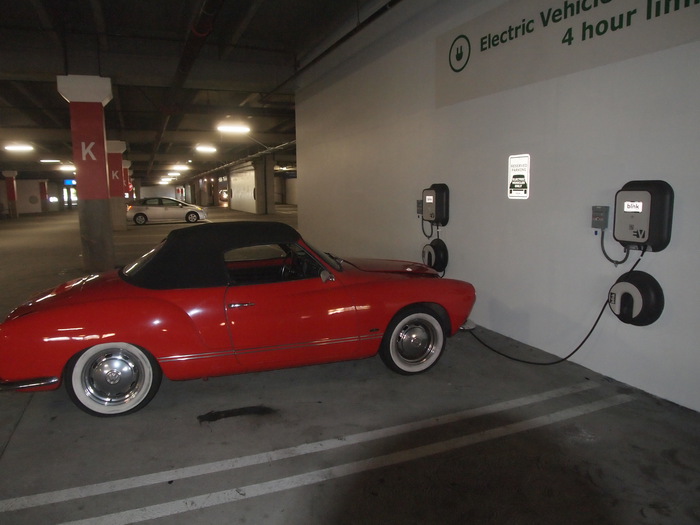I found a nearby Ikea that had a Blink charging station and set off with my laser thermometer gizmo. I’d intended to also find a ChargePoint station for fairness, to check temperatures while charging on one of their stations. But I ran out of time on the day of the test. I also drove my car up and down the highway a fair distance so that I’d have a long enough charging session for a decent test.
The ambient temperature was such that the concrete wall of the parking garage read 50-55 degrees.
The charger has a volts/amps/kilowatts display on the front, and a knob to adjust the charging rate. I started it at 30 amps which equated to 5.8 kilowatts, and the voltage read 196 volts. After a few minutes however I bumped the charge rate to a bit over 8 kilowatts, wanting to give the connector a real good test.
Every five minutes I took and recorded temperature readings made with the laser thermometer. The entire session lasted about an hour, which I ended when the BMS first told the charger to shut off because some cells had reached the high voltage threshold.
To charge with J1772, I use a small adapter box bought off eBay that has J1772 on one side and a NEMA 14-50 on the other side.
It took a half hour before temperatures of anything rose appreciably above ambient temperature. The first to show signs of heating was the adapter box and the cable going to the charger. At 20 minutes they read at around 80 degrees F, and at the end of the hour their temperature had risen to the 85-95 degrees F range.
During the charging session I could only measure the outsides of the cables and connectors. None were more than comfortably warm. For example the outside shell of the J1772 connector reached at most 85-90 degrees F, as did the J1772 socket on the adapter box.
However there was a different story at the end of the charging session, when I could measure temperatures of the pins in the J1772 connectors.
For the pins in the J1772 socket on the adapter box, their temperature range was in the 110-130 degrees F range with a couple readings close to 150 degrees F.
However, for the J1772 connector on the end of the Blink station charging cord, the highest temperature read was 165 degrees F, again with other temperatures in the 110-130 degrees F range.
Generally speaking it appeared the Blink connector was hotter than was the socket on the adapter box.
What do I mean by temperatures in the 110-130 range with a few high temperatures? I painted the laser around the device to get a read of the overall temperature range. The high temperatures were found inside the connector pins which carry the high current. There are three such pins.
The J1772 connector on the end of the Blink cord appears to be the culprit. It has a label saying it was made by REMA, Model # REV-1-30C, Type 3R, and most importantly is rated for a maximum 240 volts 30 amps.
Let that sink in for a moment… Rated for: 240 volts, 30 amps. Yes, that calculates out to a 6 kilowatt or so charge rate. So what’s the problem?
The problem is that it’s best to, and there may be a requirement to, use components whose rating is a bit larger than required by the application. At the time the Blink stations were designed, the Nissan Leaf with its 16 amp 3.3 kilowatt charge rate was the norm. However, in 2012 three cars with more powerful on-board chargers were introduced (Coda, Ford Focus Electric, Toyota RAV4 EV).
ECOtality should have foreseen that the anemically slow 3.3 kilowatt charging rate would be eclipsed by more powerful chargers in short order. They should have had access to the automakers and known what were the plans. But they designed the Blink stations to be barely adequate to handle electric cars with higher powered chargers.
Is it a problem that the temperature of the pins rose to 160 degrees F after an hour of 8 kilowatts charging? I don’t know. But I do wonder what will happen after 3-4 hours of 6.6 kilowatts of charging.
Source: green.autoblog.com![]() and plugincars.com
and plugincars.com![]()
Here are my raw notes —
- Highway design could decrease death and injury risk, if “we” chose smarter designs - March 28, 2015
- GM really did trademark “range anxiety”, only later to abandon that mark - March 25, 2015
- US Government releases new regulations on hydraulic fracturing, that some call “toothless” - March 20, 2015
- Tesla Motors magic pill to solve range anxiety doesn’t quite instill range confidence - March 19, 2015
- Update on Galena IL oil train – 21 cars involved, which were the supposedly safer CP1232 design - March 7, 2015
- Another oil bomb train – why are they shipping crude oil by train? – Symptoms of fossil fuel addiction - March 6, 2015
- Chevron relinquishes fracking in Romania, as part of broader pull-out from Eastern European fracking operations - February 22, 2015
- Answer anti- electric car articles with truth and pride – truth outshines all distortions - February 19, 2015
- Apple taking big risk on developing a car? Please, Apple, don’t go there! - February 16, 2015
- Toyota, Nissan, Honda working on Japanese fuel cell infrastructure for Japanese government - February 12, 2015



















